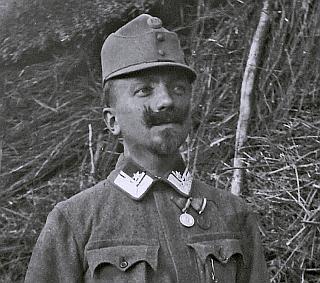
Jan Vaněk was arguably the most obvious of all the prototypes of characters in The Good Soldier Švejk.
The Who's who page on Jaroslav Hašek presents a gallery of persons from real life who to a varying degree are associated with The Good Soldier Švejk and his creator. Several of the characters in the novel are known to be based on real-life people, mostly officers from Infanterieregiment Nr. 91. Some of Hašek's literary figures carry the full names of their model, some are only thinly disguised and some names diverge from that of their "model", but they can be pinpointed by analyzing the circumstances in which they appear.
A handful of "prototypes" are easily recognisable like Rudolf Lukas and Jan Vaněk, others like Zdeněk Matěj Kuděj and Emanuél Michálek are less obvious inspirations. One would also assume that most of these characters borrow traits from more than one person, one such example is Švejk himself.
A far larger number of assumed prototypes are connected to their literary counterparts by little more than the name. Josef Švejk is here the prime example, but Jan Eybl also fits in this category. The list of prototypes only contains those who inspired characters that directly take part in the plot.
Researchers, the so-called Haškologists, are also included on this page but this list is per 15 June 2022 restricted to Radko Pytlík and two important but relatively unknown contributors to our knowledge about Hašek and Švejk. In due course entries on other experts like Václav Menger and Zdena Ančík will be added.
 | Lacina, Ludvík Jakub | |||||||
| *25.7.1868 Nedakonice - †15.7.1928 Valašské Meziříčí | ||||||||
| ||||||||
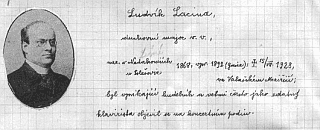

Birth and baptism record
Lacina was a Roman-Catholic priest from Moravia who served in k.u.k. Heer as a regular army chaplain from 1906 to 1918. Due to the fact that he from 1913 to 1916 was assigned to Kavalleriedivision Nr. 7 and moreover was the only military cleric with this surname in Austria-Hungary, there is no doubt that he was the model for the literary Feldoberkurat Lacina. He was identified as Hašek's feldkurát in an obituary printed in Národní listy in 1928.
Early life
Son of the teacher Ludvík Lacina and Emilia he was born in 1868 in Nedakonice, okres Uherské Hradiště in Moravia, his right of domicile was Nedakonice. In 1877 his father took up a position as teacher in Nový Hrozenkov on the Slovakian border and in 1881 he became head teacher in Lešná by Valašské Meziříčí, a position he held until 1902. His son Ludvík must therefore have lived at all these places before moving to Olomouc to embark on his clerical education. Eventually Lacina Sr. moved the short way Krásná nad Bečvou (now part of Valašské Meziříčí) where he continued as head teacher and also was elected mayor.
Civilian career
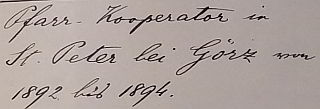
© ÖStA
Lacina studied at the Czech gymnasium in Valašské Meziříčí where he graduated in 1887, then theology in Olomouc and Gorizia (Görz). He was drafted into the armed forces in 1888, but details about his compulsory service in k.u.k. Heer are missing. He is however listed as a reserve field chaplain in 1899. He was ordained priest in Gorizia 18 April 1892. For the next two years he worked as chaplain at the parish in nearby Šempeter pri Gorici (St. Peter bei Görz).
, 1896 , 1907

In 1894 he moved to Vienna and appears in the address book from 1897 under the name Ljudevik Lacina, title Priester. He lived in Wiedner Hauptstrasse 82, IV. Bezirk. In Wiener Kommunal-Kalender und städtisches Jahrbuch (Vienna Municipal Calendar and City Yearbook) from 1896 he is entered as a teacher of Catholic religion at a primary school in Leopold Ernstgasse 37.
Lacina worked as a teacher until 1906, the year he joined the army as a regular field chaplain. The city yearbooks reveal that the taught both boys and girls (these were gender segregated schools) but often changed schools. He is listed at no less than eight home addresses up to and including 1909. His address in 1906 year was Wurlitzer-gasse 9, XVI. Bezirk. He lived in at least three of the capital's districts during his 14 year stay in Vienna.
Cyclist and musician

Ostdeutsche Rundschau, 6.5.1900
In the cultural sphere he was very active, particularly in music where he excelled as a singer, and also played the piano and accordion. As a student at Musikschule Kaiser in 1900 and 1901 he passed the Staatsprüfung (state exam) in singing, piano- and organ-playing.
, 3.12.1899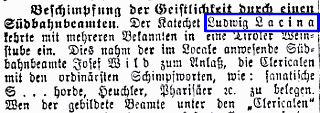
Lacina was also an active cyclist and newspapers record that he to great acclaim played the piano at the gatherings of the Christian Cyclists Association.
In December 1899 the cyclist and cleric Lacina hit the headlines. Sitting with a group of other cyclists in Tiroler Weinstube on 11 July 1899 they overheard a railway employee describing the Social-Clerical Party as a "Saubande" (pack of swine) and added other derogatory terms. Lacina and his group objected and a heated argument erupted, indeed so heated that the belligerents ended at Polizeikommisoriat, and eventually in court. Lacina sued based on a claim that the harsh words were in insult to the entire Catholic clergy, but the defendant Josef Wild claimed it was only aimed at the Clerical Party. The court in the end acquitted the accused railway man.
In k.u.k. Heer


Našinec, 11.2.1913
On 1 November 1906 Lacina joined k.u.k. Heer as an active (i.e. professional) military cleric. The first two years he served with the Feldsuperiorat in Vienna as Feldkurat 2. Klasse, from January 1909 to February 1912 in Gorizia before he was transferred to Maribor. On 21 January 1913 he changed assignment again, now to Kavalleriedivision Nr. 7 in Kraków, the division that is mentioned by Hašek in The Good Soldier Švejk. With this division he served in the field from the outbreak of war. In 1915 he was decorated with Geistliche Verdienstkreuz zweiter Klasse am Weissroten Bande. In August 1916 he was transferred to K.u.k Mobiles Reserve-Spital Nr. 2/10, serving with the 2nd Army behind the lines on the Eastern Front.
Documents from the Czechoslovak army state that he during the war had served in Russian Poland, Galicia and finally 18 months in Albania. These records do not contain any firm dates for his assignments in k.u.k. Heer.
Disciplinary record
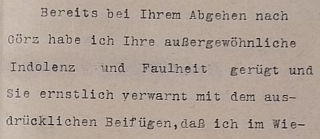
One of the many warnings Lacina received from k.u.k. Feldvikariat in Vienna. The letter is dated 16 March 1910, at the time Lacina served in Görz (now Gorizia in Italy and Nova Gorica in Slovenia).
© ÖStA
When he entered the army clergy Lacina had a spotless record, but this was soon to change. Several incidents are record during his 12 year army career, resulting in several written warnings. Lacina however defended himself quite eloquently and the measures taken against him never seem to have gone beyond reprimands and transfers.
Warned by military bishop Bjelik, 22 March 1911 © ÖStA Testimony from the Capuchinian monastry in Gorizia © ÖStA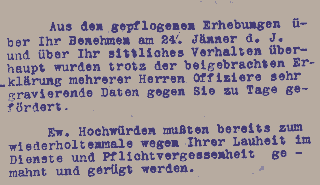
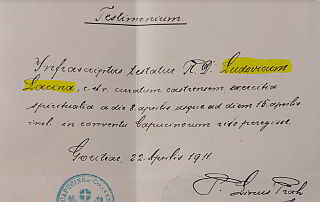
The first recorded incident happened in March 1910 in Gorizia when Lacina allegedly charged the widow of an officer 6 crowns for her late husband's funeral and adjoining holy mass. K.u.k. Feldvikariat in Vienna issued a strong-worded reaction where the field chaplain was told that "he, despite previous warnings, didn't seem to have bettered himself". He was berated for his "filthy greed" and "unusual laziness and indolence", and the Feldvikar (Roman-Catholic military bishop) had "lost every remaining trust in him (Lacina) that he ever had". Expulsion from k.u.k. Militärseelsorge loomed, but in the end he was shown mercy and was allowed to continue. It will have helped that fellow officers put in a good word for him.
Less than a year later he was in trouble again. During a masquerade ball at Deutsche Schulverein in Gorizia on 21 January 1911 Lacina was present and he was soon after accused of behaviour that was incompatible with that expected of a military cleric. Reportedly he was involved in some joke with an officer dressed as a lady, and this was deemed inappropriate. More gravely he was accused of letting a lady sleep over at his flat. These incidents caused gossip and consternation in the city, and reflected badly on the military clergy as a whole. Again fellow officers backed him, but a few months later he received a stern warning from military bishop Bjelik. He was offered to voluntarily resign within 6 months, and if anything untoward happened during this period he would be dismissed.
He was even ordered to report at a monastery for eight days to undergo geistliche Exercisien (spiritual retreats). In a letter dated 22 April 1911 he informed his superior in Vienna that he underwent spiritual cleansing at Kapuzinerkloster in Gorizia, and the attached testimony from the monastery (written in Latin) confirms that this took place from 8 to 15 April.
The incident at the masquerade ball is almost certainly the reason for his transfer from Gorizia to Maribor. This seems to have taken place in February 1912.
During the war
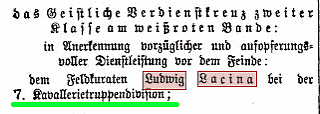
,25.12.1915
When the war broke out he was still with Kavalleriedivision Nr. 7 in Kraków, he served with this unit at the front in Poland and Galicia from 1 August 1914 to 14 August 1916. In 1915 he was decorated but in 1916 the division requested that he be transferred to a less demanding post as he "was not up to the tasks demanded by a cavalry division".
© ÖStA
He was thus in August 1916 transferred to Mobile Reservespital Nr. 2/10 (the 10th mobile reserve hospital of the 2nd army), but before that he had been proposed for promotion by Kavalleriedivision Nr. 7. The attempted promotion was so-called Aussertourlich (out of turn) as 29 priests were ahead of him in the queue for promotion. Military bishop Emmerich Bjelik therefore rejected the application, not only for this reason but also due to the field chaplain's relatively short time of service (10 years) and his poor disciplinary record.
© ÖStA
The rejection led to another incident and this time the bishop himself was on the receiving end. Lacina turned up in the bishop's office on 18 October 1916 to enquire about the promotion. When told the verdict he lost his temper and lashed out at his superior, accusing Bjelik of persecuting him and wished that the Mother of God punish him. The bishop was in the end pretty lenient: he reported the incident to k.u.k. Kriegsministerium but asked that the punishment be no more a stern warning.
Miha Šimac has during his research recorded Bjelik's disciplinary report on Lacina, and reproduces it in his book Vojaški duhovniki iz slovenskih dežel pod habsburškim žezlom, Ljubljana: Teološka fakulteta, 2014, page 373-374.
Feldkurat Lacina – Disziplinärwidriges Genehmen
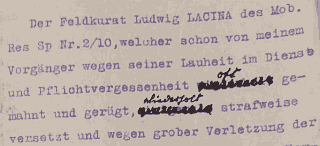
© ÖStA
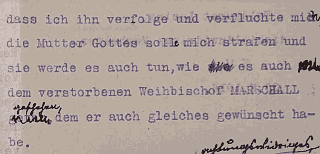
© ÖStA
Der Feldkurat Lacina des Mob. ResSpitals Nr. 2/10, welcher schon von meinem Vorgänger wegen seiner Lauheit im Dienste und Pflichtvergessenheit oft gemahnt und gerügt, wiederholt strafweise versetzt und wegen grober Verletzung der Standesehre auch mit einem strengen Verweise bestraft, von den namentlich jüngeren Offizieren aber, - weil er ein guter Gesellschafter, Klavierspieler und kein Spassverderber war – gerne in Schutz genommen wurde, ist mit Befürwortung des 2. A-Kmdos von der 7. KTD zur Beförderung in die VIII. Rangklasse außer der [Bar. ?] beantragt worden. Inspcection and neglected patients. © ÖStA
Er ist am 18. i. Mts. bei mir erschienen und hat sich auf den vorerwähnten Antrag berufen und um seine Beförderung gebeten. Ich habe unter Hinweis auf sein so oft beanständetes Verhalten vor dem Kriege die Erfüllung dieser Bitte abgelehnt und musste dies, als er unter Hervorhebung seiner 10-jährigen Dienstzeit und seines Alters das Ansuchen mit heftigem, ungebührendem Ton und eben solcher Haltung wiederholte als eine Dreistigkeit und Kränkung seiner wohlverdienten Vordermänner energisch zurückweisen. Er gebärdete sich aber in ungehöriger Art weiter und warf mit verletzendem Ton und anmassender Haltung vor, dass ich ihn verfolge und verfluchte mich, die Mutter Gottes solle mich strafen und sie werde es auch tun, wie es auch dem verstorbenen Weihbischof Marschall geschehen, dem er auch gleiches gewünscht habe. Ich bringe dieses achtungswidrige, die Auktorität und Disziplin tief verletzende Benehmen des Feldkuraten Lacina zur Kenntnis und bitte, - da es sich um meine Persone handelt, - von einer härteren Ahndung absehen und ihn nur mit einem strengen Verweise und Verwarnung bestrafen lassen zu wollen.
Bjelik, Bischof, Apostolischer Feldvikar

Throughout the rest of 1916 and 1917 Lacina continued in the mobile reserve hospital and again there were controversies. During an inspection on 4 December 1916 by Feldsuperior Várady a number of wounded soldiers at the hospital complained that they had not received Holy Communion from the field chaplain for eight weeks.
In September 1917 he was also accused of having arranged illicit collection of money from the hospital's patients. Lacina energetically refuted the accusations and requested that the case be investigated by the military judiciary. On 7 October 1917 XIX. Korpskommando concluded that he indeed had committed a transgression but had not violated the letter of the law. The case was thus left for the Feldsuperiorat to decide. The latest recorded correspondence regarding the matter is dated 16 December 1917 and the outcome is unclear.
Location

Locating Lacina's unit: Albania 1917
© ÖStA
One of the documents suggests that the reserve hospital was located in the cavalry barracks of Kamionka Strumiłowa in 1916 and this makes sense as the 2nd army operating in eastern Galicia at the time. His documents from the Czechoslovak army claim that he served for 18 months in Albania, and the correspondence regarding the money collection case shows the location of Feldsuperiorat as Skutari (now Shkodër). It thus appears that the mobile reserve hospital was transported to Albania in early 1917.
His whereabouts during 1918 are not known, apart from the fact that he was back in his native Moravia by the time Austria-Hungary collapsed and that he on 14 August 1918 had arrived in the spa town of Karlsbad (Karlovy Vary), registered with permanent address Krasna.
In the Czechoslovak Army
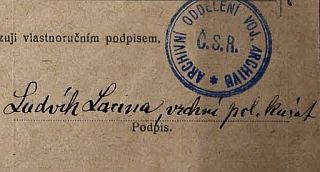
© VÚA
When Czechoslovak independence was declared 28 October 1918 he was stationed in Hranice na Moravě and immediately joined the army of the newly formed state where he remained as an active military cleric for another three years. In the Czechoslovak Army his record is spotless and the army documents do not mention any of the disciplinary issues from his time k.u.k. Heer.
On 3 May 1919 he was promoted to vrchní polní kurát (chief field chaplain) and was stationed in Hranice na Moravě, Moravská Ostrava, Hradec Králové, Chomutov, and Pardubice. From 22 January 1921 he reported ill and was hospitalised in Pardubice and Prague. He was eventually superarbitrated on 26 August 1921 and retired on 27 September 1921. The reasons for his illness and early retirement are not yet known. Lacina died in his native Moravia at the age of 60 and is buried in Valašské Meziříčí.
Meeting Hašek before the war?

Radko Pytlik, 1983

, 2003
The fact that Jaroslav Hašek knew exactly what unit Lacina served with indicates that the two met in person at some stage. According to Radko Pytlík and his book Kniha o Švejkovi p.146, Hašek met Lacina on one of his wanderings before the war and that the latter had a liking for animals, both alive and on the dinner table, and that this may have drawn the attention of the author.
When and where the two could have met is however not clear because the author's and the field chaplain's domiciles never overlapped, and Hašek is not known to have travelled to areas where Lacina lived at the time (the opposite is of course possible). Nor do we know where Radko Pytlík has the information from, but he mentions the first name Ludvík and the geographical affinity to Valašské Meziříčí so the source appears reliable enough. In his book Osudy a cesty Josefa Švejka (2003) Pytlík elaborates on the theme and suggests that the two met already when Hašek was editor of Svět zvířat (1909-1910)[a]. Pytlík also adds that Lacina was a frequent guest in bars and coffee houses. ,12.1.1913
Given the fact that Hašek knew what unit the field chaplain served with, any meeting between the two is unlikely to have happened before January 1913 when Lacina was transferred to Kavalleriedivision Nr. 7 in Kraków. In the summers of 1913 and 1914 Jaroslav Hašek together with Zdeněk Matěj Kuděj undertook two major trips, both in Bohemia, i.e. in areas where Lacina would not typically spend time. Kuděj later described both journeys in detail and never mentioned any field chaplain. In the autumn of 1914 Hašek spent some time around Jaroměř but it seems unlikely that Lacina at the time ventured in this area. He had after all just been called up for front duty.
Meeting Hašek in 1915?

From the book O Szwejku i o nas (2002)
© Antoni Kroh
That the two met during the war is also possible, and if so it is likely to have happened when the field chaplain was on leave, a hypothesis supported by the fact that the literary Lacina turned up at the railway station in Budějovice in a hard hat, indicating that he was off duty. Could he have been visiting someone in the city around 1 June 1915 when Ersatzbataillon IR. 91 departed for Bruck an der Leitha - Királyhida? That the two met in the field later that year is unlikely as Kavalleriedivision Nr. 7 didn't operate in the same areas as Infanterieregiment Nr. 91.
Polish translator of The Good Soldier Švejk, Antoni Kroh, claims that Hašek met Lacina on the way to the front in Galicia, but does not reveal the source of this information.
Pardubice 1920?

Lacina served in Pardubice when Hašek was there.
© VÚA
A more tangible link is Pardubice where Jaroslav Hašek and his wife spent a week in quarantine after returning from Russia in December 1920. From 1 October 1920 to 27 September 1921 Lacina served with the local garrison in the 2nd reserve hospital, now of course as a Czechoslovak officer.
Interestingly enough he had by now advanced to chief field chaplain, exactly the rank Jaroslav Hašek assigned to him in The Good Soldier Švejk. This may however not mean much as the author quite liberally juggled ranks (this was the case also with Feldoberkurat Ibl).
Another caricature?
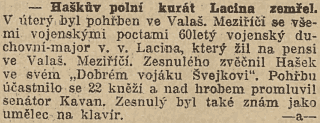
,20.7.1928
It's open to speculation whether the grotesque traits that Jaroslav Hašek assigns to the chief field chaplain has any root in reality. Two of the field chaplains that take part in the plot are obvious caricatures without any obvious model from real life (Feldkurat Katz and Feldkurat Martinec), one does share a name with a real field chaplain (Feldoberkurat Ibl) but not much else. Lacina therefore remains the only field chaplain with some firm connection to a real person. The personal traits and situations that Hašek assigns to his Feldoberkurat travelling with Švejk and Einjährigfreiwilliger Marek are obvious caricatures, but there is no doubt that Lacina was a loose cannon in Militärseelsorge. Although not officially recorded, it is quite possible that his excesses also included drunkenness and gluttony.
Credit: Miha Šimac, Václav Petera, Jaroslav Šerák, Radko Pytlík, VÚA, ÖStA
Literature
- Osudy a cesty Josefa Švejka, ,2003
- Lacina Ludvík,
- Ludvík Lacina,
- Matrika, Nedakonice,
- K.u.k. Militär- und Marinegeistlichket 1907,
- 7. Nachweis. Einwohner von Wien nebst Floridsdorf und Jedlersdorf, ,1901
- Lehreranstellungen, ,5.2.1877
- Lehrer-Ernennungen, ,24.11.1881
- Abiturienti, rok 1887,
- Die erste Verbandspartie des Verbandes der christlichen Radfahrer Oesterreichs, ,23.4.1899
- Der Geistliche in Radfahrerdress, ,2.12.1899
- Musik-Staatsprüfungen, ,27.6.1901
- Zu ernennen, ,28.10.1906
- Aus dem Armee-Verordnungsblatte, ,9.1.1909
- Z c.a.k. apoštolského polního vikariátu, ,19.2.1909
- Novarafeier des 47. Infanterieregimentes, ,30.3.1909
- Aus dem Heeresverordnungsblatt, ,12.1.1913
- Auszeichnungen für Verdienste om Kriege, ,6.11.1916
- Angemeldet am 14. August 1918, ,16.8.1918
- Vrchním polním kurátem, ,17.5.1919
- Přeložini do vyslužby, ,10.12.1921
- Odvolání, ,6.11.1925
- Haškův polní kurát Lacina zemřel, ,20.7.1928
- Val. Meziříčí, ,9.8.1928
- Zemřeli, ,22.12.1928
| a | Osudy a cesty Josefa Švejka | 2003 |
| © 2008 - 2024 Jomar Hønsi | Last updated: 23.11.2024 |



